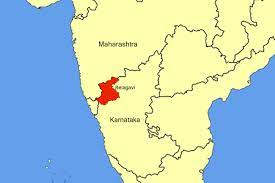The Belagavi Border Dispute:

An inter-state dispute between Karnataka and Maharashtra dating back to the period of Independence and the reorganisation of states on linguistic lines in 1956 has reared its head again in the Belagavi region of Karnataka.
- The latest flashpoint is following a series of minor incidents over the last week that have inflamed pro-Kannada and pro-Marathi passions on the two sides of the border.
- The erstwhile Bombay Presidency, a multilingual province, included the present-day Karnataka districts of Vijayapura, Belagavi, Dharwad and Uttara-Kannada.
- In 1948, the Belgaum municipality requested that the district, having a predominantly Marathi-speaking population, be incorporated into the proposed Maharashtra state.
- However, the States Reorganisation Act of 1956, which divided states on linguistic and administrative lines, made Belgaum and 10 talukas of Bombay State a part of the then Mysore State (which was renamed Karnataka in 1973).
The Mahajan Commission report:
- While demarcating borders, the Reorganisation of States Commission sought to include talukas with a Kannada-speaking population of more than 50 per cent in Mysore.
- Opponents of the region’s inclusion in Mysore argued, and continue to argue, that Marathi-speakers outnumbered Kannadigas who lived there in 1956.
- In September 1957, the Bombay government echoed their demand and lodged a protest with the Centre, leading to the formation of the Mahajan Commission under former Chief Justice Mehr Chand Mahajan in October 1966.
- The Commission in its report in August 1967 recommended that 264 villages be transferred to Maharashtra (which formed in 1960) and that Belgaum and 247 villages remain with Karnataka.




